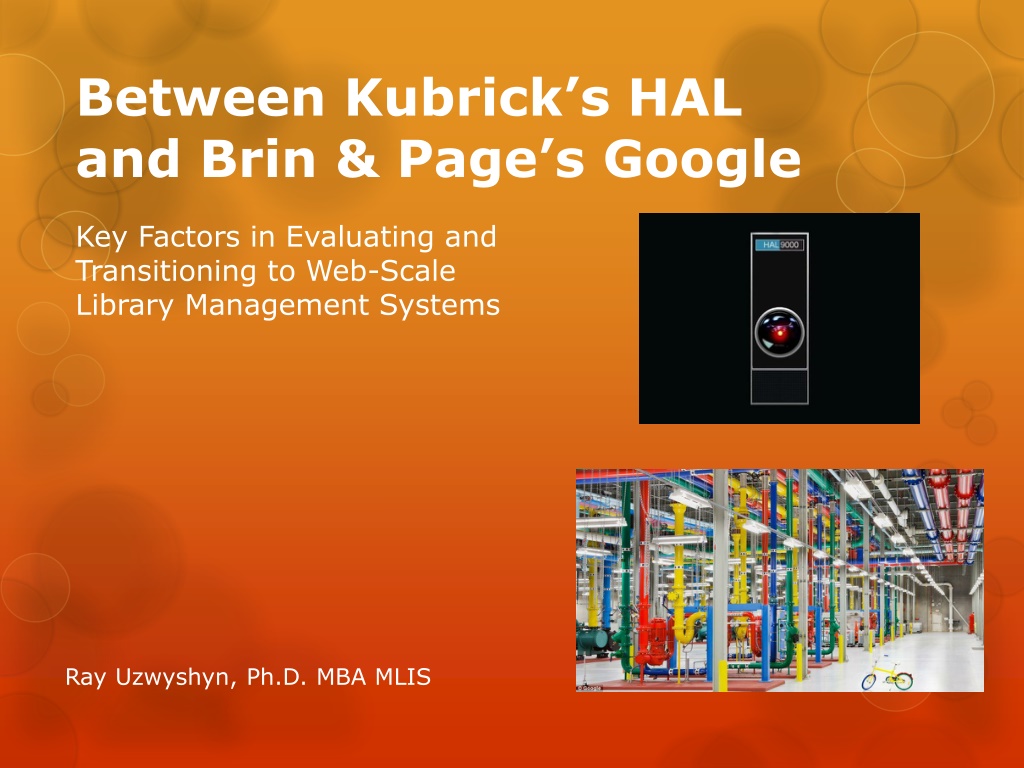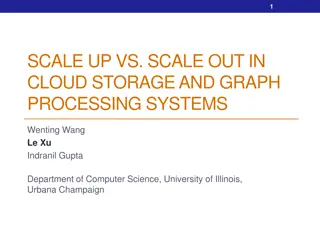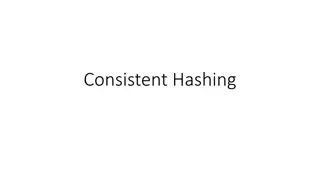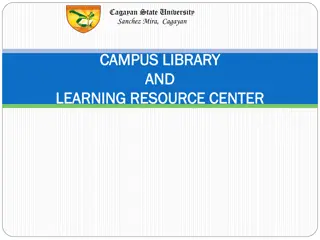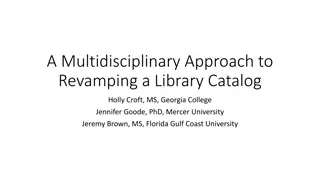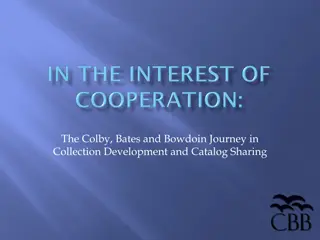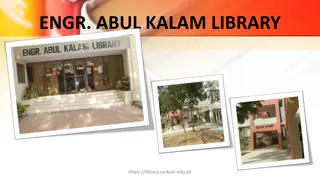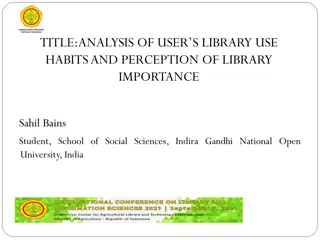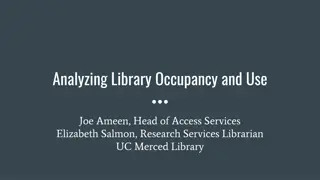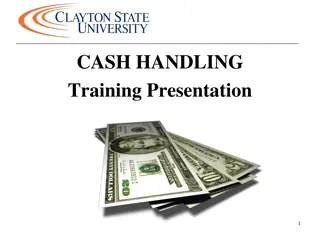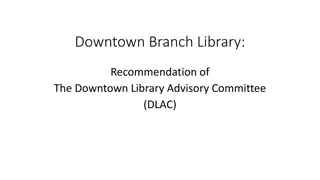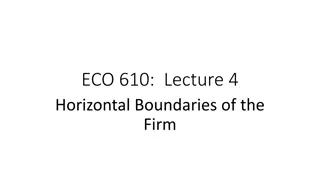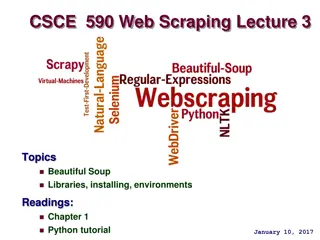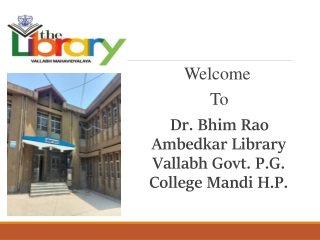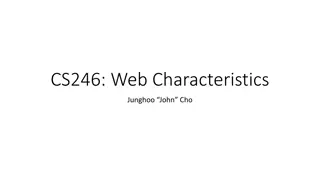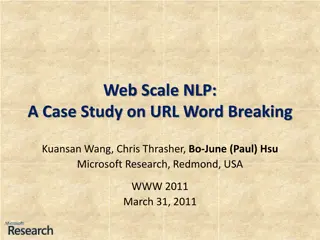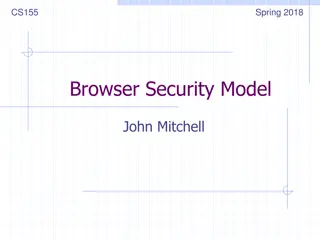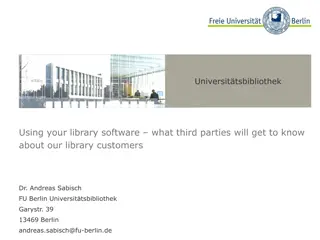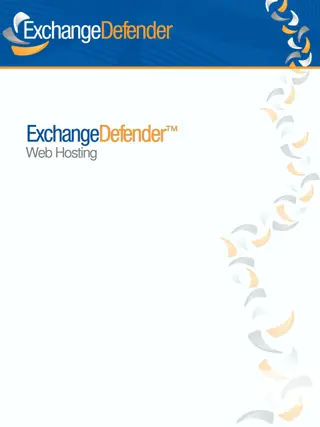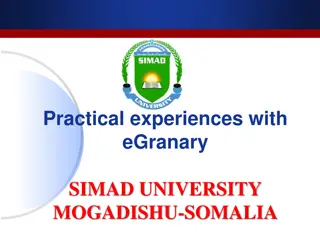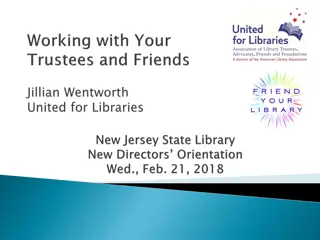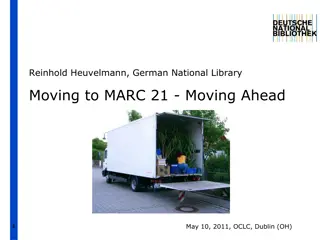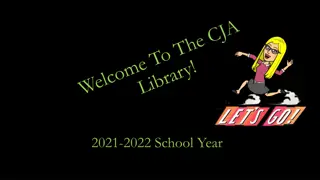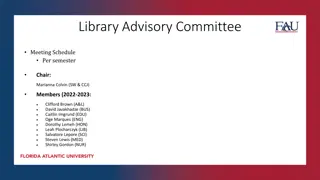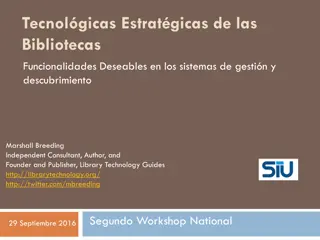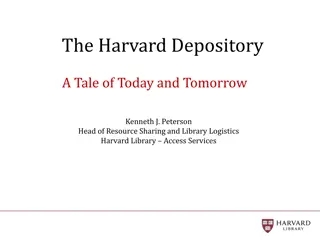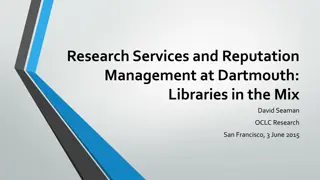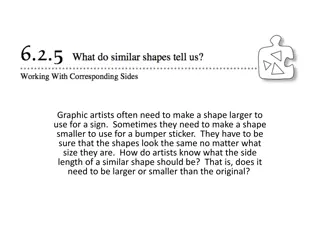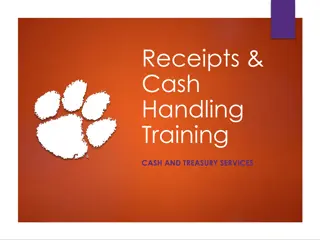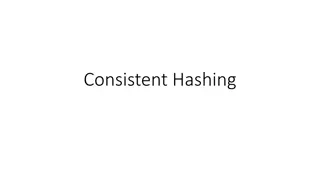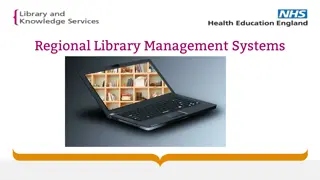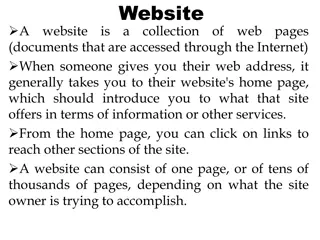Exploring Web-Scale Library Management Systems for Efficient Information Handling
Unveil the advancements in Web-Scale Library Management Systems (LMS) that are revolutionizing the management of library resources. Dive into the advantages, characteristics, and technical evaluation benchmarks of these systems, offering insights into their cost-effective, efficient, and user-centric functionalities.
Download Presentation

Please find below an Image/Link to download the presentation.
The content on the website is provided AS IS for your information and personal use only. It may not be sold, licensed, or shared on other websites without obtaining consent from the author. Download presentation by click this link. If you encounter any issues during the download, it is possible that the publisher has removed the file from their server.
E N D
Presentation Transcript
Between Kubricks HAL and Brin & Page s Google Key Factors in Evaluating and Transitioning to Web-Scale Library Management Systems Ray Uzwyshyn, Ph.D. MBA MLIS
What is a Web Scale Library Management System? Term Originated with OCLC Next Generation Enterprise Online Library Management System Software as a Service (SaaS), Cloud Computing Amalgam of Online Platform Integration, Web 2.0, industry ideas (Google, Facebook, Apple and Amazon) Several Current Competing Systems Available: Both Open Source (Koha, Evergreen) and Proprietary (OCLC Worldshare, Serial Solutions Intota, Ex Libris ALMA)
LMS Web-Scale Advantages Reduces Cost: Eliminates need for hosting multiple servers and equipment (hardware/software upgrades) Institutional IT Refocus: allows Human resources refocus on other possibilities/challenges Better Analytics: User Trends, Click Streams,Library Database Usage. Insight, Business Intelligence (BI)
Web Scale LMS General Characteristics and Evaluation Benchmarks Consolidates: Disparate Library Systems (Electronic, Digital and Print Resource Systems) Optimizes Workflows: through Shared Data, Collaborative Services, Cloud Based Infrastructure Extends Services: Redirect Library resources to focus on extending library services in support of students/faculty and teaching and research goals
Web-Scale Technical System Evaluation Characteristics Transparency & System Redundancy: Transaction level redirection, Quiet Failover (Backup Systems in Cloud) Available & Reliable 99.99% Online and Running High Performativity: Fast Response time, Quick Search/Worklevel Scalable: As University community population grows
LMS Evaluation Characteristics Interoperability: Integration with External Services (new API s, other systems and software possibilities, Social Media, Mobile etc) Secure: identity management, data protection, personal and institutional privacy Usable: Usability, Human/Computer Interaction (HCI) Economical: Cost Benefits analysis compared to current system conglomeration
LMS Key Evaluation Factors Entirely Web Based Applications: No need to purchase hardware/software Shared Data Possibility: Silos between applications, databases eliminated (i.e. Worldshare/Worldcat) Existing System Integration: Ordering, Receiving, Dataloging, higher end digital library and other integration
Key Transitioning Factors Web Scale Disadvantages Loss of Customization/configuration options Loss of Immediate In House Access (Local Expertise may be better than far flung experts) Loss of Complete Control/Security Implications Tied Strongly to One System (Integration, Legacy Systems and Future Forward Moves)
Web-Scale LMS Marketplace Players OCLC (WorldShare Management Services) - oldest system, strong app sharing, open API - strong ties with WorldCat Local data, leveraging metadata, cooperative possibilities, platform focus - strong ties with ContentDM, Digital Library Integration, MetadataFocus, OCLC cooperative analytics
OCLC Worldshare Live Metadata Integration
Serials Solutions Intota Strong Integration with Proquest, Summon (Queens Connection) Strong Integration with Serials Solutions 360 Electronic Resource Management, Reconceptualizing Collection Management Strong Assessment/ Analytics Reporting, Intota Assessment (Accreditation) Subscription Model
Ex Libris Alma Strong integration with Ex Libris Product Family (Primo, Metalib, SFX) Unified Resource Management Focus (electronic, print, digital) Alma Community Zone, SaaS
Web Scale LMS Evaluation Project Management Steps Environmental Scan of Existing Systems Convene Committee of Various Library Stakeholders Evaluate Systems at Hand Create Evaluation Matrix from Factors Identified Meet with Major Vendors/Presentations Peer Review/Benchmark ARL Colleagues Local Consortial Considerations Evaluate Outside Possibilities (Open Source etc/Other Contenders)
Quantitative and Qualitative Analysis Factors Assign System Factors & Factor Weights Develop Weighting Formula A(.8) + B(.8) + C(.8) . . .J(.8) = Total A= Reliability (.8) B = Response Time (.8) C = Scalability (.8) D = Interoperatiblity (.7) E = Security (.8) F = Cost (.6) G= Human Resources (.7) H = Analytics (.9) I = Customization (.5) J = Peer Group (.8)
Matrix Evaluation/Peer Discussion Web Scale Library Management Systems Factor Evaluation Serials Solutions Intota Weighted Factor vs/ System OCLC WorldShare Ex Libris Alma Other A= Reliability (.8) 8 6.4 7 5.6 7 5.6 8 6.4 B = Response Time (.8) 7 5.6 8 6.4 7 5.6 7 5.6 C = Scalability (.8) 6 4.8 8 6.4 8 6.4 5 4 D = Interoperatiblity (.7) 7 4.9 6 4.2 9 6.3 7 4.9 E = Security (.8) 7 5.6 4 3.2 3 2.4 7 5.6 F = Cost (.6) 8 4.8 8 4.8 7 4.2 7 4.2 G= Human Resources (.7) 7 4.9 9 6.3 7 4.9 8 5.6 H = Analytics (.9) 6 5.4 9 8.1 8 7.2 6 5.4 I = Customization (.5) 6 3 7 5.6 9 4.5 4 2 J Peer Group (.8) 8 6.4 6 3 8 6.4 8 6.4 Totals: 51.8 53.6 54 50.1 Gather Committee Scorecards
Discussions, Recommendations and Decisions (Analytic Tools and Intuition) Aggregate and Tabulate Results OCLC Committee Member Score (1) + OCLC Committee Member (N). . .= OCLC Total Committee Score/N Intota Committee Member (1) + Intota Committee Member (N). . .= Intota Total Committee Score/N Alma Committee Member (1) + Alma Committee Member (N). . .= Alma Total Committee Score/N Analytic Metric Results . . . Intuitive Tools
Thanks! Questions? Ray Uzwyshyn, Ph.D. MBA MLIS http://rayuzwyshyn.net ruzwyshyn@gmail.com
Bibliography/Web Links Penn State Evaluation http://www.libraries.psu.edu/psul/groups/webscale/overview.html Library Web Scale: Definitions (Marshall Breeding) http://www.librarytechnology.org/ltg-displaytext.pl?RC=16577 OCLC WorldShare http://oclc.org/worldshare-platform.en.html Serials Solutions Intota http://www.serialssolutions.com/en/services/intota Intota Assessment http://www.serialssolutions.com/en/services/intota/assessment ALMA http://www.exlibrisgroup.com/category/AlmaOverview
